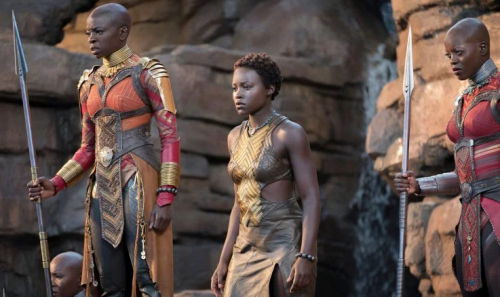Hannah Beachler, Black Panther’s production designer, says a 400-year-old Nigerian language was one of the two languages that inspired Wakanda’s language.
Wakanda is a fictional country and was used as location in some parts of the movie, Black Panther.
Nsibidi, a language formerly used in parts of Cross River, was used repeatedly through the course of the movie as the language of the fictional Wakanda kingdom.
In an interview with Indie Wire, Beachler said the remnants of Nsibidi were combined with Roman numerals to create an advanced Nsibidi script.
“Using lines and dots, Nsibidi was expanded with an array of symbols, initially inspired by Chinese, Arabic, and Dogon and Murci of Africa,” she said.
“It was a secretive language, based on pictography, so it was about how you put the symbols together and the image you create.
“The language needed to evolve from the older hieroglyphs into a more modern version. We used it in a pictograph way but the numerical system stayed the same.”
In the throne room, where T’Challa, played by Chadwick Boseman, sat traditional Nsibidi symbols inscribed on a large column were visible, with smaller columns containing the more modern version of the language denoting the various names of the tribes in the movie.
“Ryan wanted a newer script that felt African but was really advanced,” Bleacher said, explaining how she discovered the language.
“I started looking at different cave drawings, we looked at LA graffiti artist Retna and were inspired by his being able to create these characters that were fresh, and started playing and playing. I did three or four passes and so did a couple of the illustrators. We mixed them, bringing our own aesthetic to it and made an entire alphabet.”
The process of bringing Nsibidi to life took Beachler and Coogler six months.
The movie has grossed over $700 million worldwide as at Sunday.
Copyright 2025 TheCable. All rights reserved. This material, and other digital content on this website, may not be reproduced, published, broadcast, rewritten or redistributed in whole or in part without prior express written permission from TheCable.
Follow us on twitter @Thecablestyle


Nsibidi was Arochukwu secret language code, used and known by persons in their secret cults. Although the Aros regard themselves as Igbo, they are nearer to Cross River state areas than most parts of Igbo land. They spread their influence around, pervading the Igbo hinterland and environs with their religion, wits and cruelty – enslaving and selling their less savvy neighbours to distant peoples.
Wrong info, Chidi. Nsibidi was adopted by some Igbo communities from the originals, Cross River people, Ekoi/Efik/Ibibio.
A Chinese speaking French does not mean he originated the language.
Thank you chidi, Nsibidi is Arochukwu.
abichidi is known as nsibidi
Nsibidi is still the core picturegraphic signs artistically and creatively displayed through Ekpe Masquerade performance.
Nsibidi can only be practiced by only those initiated into The Ekpe society. The initiated Ekpe members can read, understand and correctly interpret the meanings of the sign.
The sign is used to communicate among Ekpe masquerades and their members. Nsibidi is mostly in full display when an Ekpe masquerade wants to challenge and intimidate an encroaching Ekpe masquerade.
Calabar festival/Carnival which holds annually in the month of December does showcase full Ekpe masquerade performances. A Google search on Ekpe Masquerade will reveal their patented Lion moves loaded with Nsibidi signs. Ekpe means Lion and as Lion is the king of the jungle so is Ekpe the king of traditional Masquerades in The Efiok Kingdom.